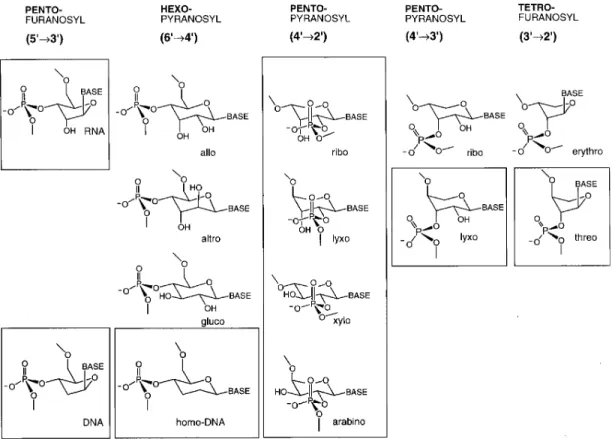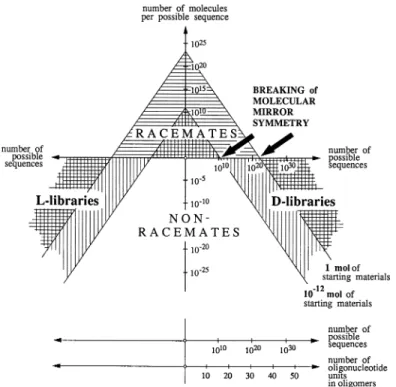Pure Appl. Chem., Vol. 72, No. 3, pp. 343–345, 2000. © 2000 IUPAC
343
*Lecture presented at the 5th International IUPAC Symposium on Bioorganic Chemistry (ISBOC-5), Pune, India, 30 January– 4 February, 2000. Other presentations are published in this issue, pp. 333–383.
†Corresponding author
Chemical etiology of nucleic acid structure*
A. Eschenmoser
†and R. Krishnamurthy
The Skaggs Institute for Chemical Biology, TSRI, La Jolla, California 92037, USA; Laboratorium für Organische Chemie, ETH, CH-8092 Zürich, Switzerland
Abstract: The synthesis of potentially natural nucleic acid alternatives and comparison of
some of their chemical properties with those of RNA and DNA have led to findings that we consider to be relevant in the context of a chemical etiology of nucleic acid structure. Chemical etiology of nucleic acid structure refers to systematic experimental studies aimed at narrowing the diversity of possible answers to the question of why nature chose the structure type of ribofuranosyl nucleic acids, rather than some other family of molecular structures, as the molecular basis of life’s genetic system. The experimental strategy is to conceive potentially natural alternatives to the nucleic acid structure, to synthesize such alternatives by chemical methods, and to compare them with the natural nucleic acids with respect to those chemical properties that are fundamental to the biological function of RNA and DNA (Fig. 1).
In the course of these studies it was found that all four members of the family of pentopyranosyl-(4'Æ2')-oligonucleotide systems that contain b-ribo, b-xylo-, a-lyxo- or a-arabinopyranosyl units as
repeating sugar building blocks are found to be much stronger Watson–Crick base-pairing systems than RNA [1–3]. The a-arabinopyranosyl system is the strongest of all, in fact, it belongs to the strongest
oligonucleotide base-pairing systems known. We conclude that, whatever the chemical determinants by which nature selected RNA as a genetic system, maximization of base-pairing strengths within the domain of pentose-derived oligonucleotide systems was not the critical selection criterion [4] (Fig. 2). The so far experimentally most comprehensively studied system among the potentially natural sugar-based nucleic acid alternatives is the pyranosyl isomer of RNA. One of the chemical properties of this system provides a transparent illustration of the intrinsic potential of an informational oligomer system to break molecular mirror symmetry. Hemi-self-complementary p-RNA tetramer-2',3'-cyclophosphates were shown to undergo efficient self-templating ligation to higher oligomers with high sequence-, regio-, and chiro-selectivity. Tetramers with differing, but fitting, hemi-complementary base sequences can undergo stochastic co-oligomerization to give rise to large libraries of p-RNA sequences. The high chiroselectivity of the ligation process leads one to think of a scenario in which a comprehen-sively stochastic co-oligomerization process starting from the heterochiral and strictly racemic library of all eight possible diastereomers of all possible tetramer-2',3'-cyclophosphates (256 = 44) would
nec-essarily break molecular mirror symmetry of higher oligomers in the sense that the resulting (equal amounts of) homochiral D- and L-libraries of a given (high) oligomer would not constitute a racemic
mixture since the two libraries would have to have different sequence compositions by statistical rea-sons (Fig. 3).
A thought-experiment in which this kind of capacity of an informational oligomer system is combined with a capability of such (largely) homochiral libraries to undergo self-selection by molecu-lar evolution points to a way of how, in principle, biomolecumolecu-lar homochirality could have emerged without a need for any chiral influence from the physical environment [5].
344 A. ESCHENMOSER et al.
© 2000 IUPAC, Pure and Applied Chemistry 72, 343–345 REFERENCES
1. M. Beier, F. Reck, T. Wagner, R. Krishnamurthy, A. Eschenmoser. Science 283, 699 (1999). 2. O. Jungmann, H. Wippo, M. Stanek, H. K. Huynh, R. Krishnamurthy, A. Eschenmoser. Org.
Letters 1, 1527 (1999).
3. F. Reck, H. Wippo, R. Kudick, R. Krishnamurthy, A. Eschenmoser. Org. Letters 1, 1531 (1999). 4. A. Eschenmoser. Science 284, 2118 (1999).
5. M. Bolli, R. Micura, A. Eschenmoser. Chem. Biol. 4, 309 (1997).
Chemical etiology of nucleic acid structure 345
© 2000 IUPAC, Pure and Applied Chemistry 72, 343–345
Fig. 2 Base-pairing strength landscape of pentose-derived oligonucleotide systems (Tm’s of duplexes A8/T8, 10 mM, 1M NaCl).
Fig. 3 Breaking of molecular mirror symmetry by stochastic chiroselective co-oligomerization in oligonucleotide systems.

